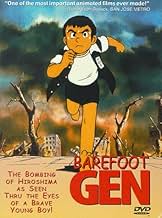Une déclaration puissante contre la guerre, Barefoot Gen est une histoire troublante sur l'effet de la bombe atomique sur la vie d'un garçon et la vie du peuple japonais.Une déclaration puissante contre la guerre, Barefoot Gen est une histoire troublante sur l'effet de la bombe atomique sur la vie d'un garçon et la vie du peuple japonais.Une déclaration puissante contre la guerre, Barefoot Gen est une histoire troublante sur l'effet de la bombe atomique sur la vie d'un garçon et la vie du peuple japonais.
- Récompenses
- 1 victoire au total
- Gen
- (voix)
- Gen (1995)
- (English version)
- (voix)
- Kimie
- (voix)
- Kimie (1995)
- (English version)
- (voix)
- Shinji
- (voix)
- …
- Shinji (1995)
- (English version)
- (voix)
- (as Brianne Siddal)
- Ryuta (1995)
- (English version)
- (voix)
- Daikichi
- (voix)
- Daikichi (1995)
- (English version)
- (voix)
- (as Kurk Thornton)
- Eiko
- (voix)
- Eiko (1995)
- (English version)
- (voix)
- Eizo
- (voix)
- Eizo
- (English version)
- (voix)
- (as Amike McConnohie)
- …
- Seiji
- (voix)
- Hana
- (voix)
- Pak
- (voix)
- Pak
- (English version)
- (voix)
- …
Histoire
Le saviez-vous
- AnecdotesThe author of the "Barefoot Gen" manga, Keiji Nakazawa, said that 70% of the story is based on true events from his experience of the atomic bombing of Hiroshima.
- GaffesWhen Gen and Shinji take a big bite from a sweet potato from each end, they are then told by Eiko to give the sweet potato to their mother. Once the sweet potato is given to her, it is whole again.
- Citations
Daikichi Nakaoka: This war can't be right. But it's only the cowards like me who dare say it. If there were only a few more like us. You know, sometimes it takes more courage not to fight than to fight, to not want to kill when all around you are calling out for blood. That's real courage in my book. If you boys remember nothing else I teach you, I hope you'll remember that.
- Crédits fousThe closing credits run horizontally from the left side. Above the credits is footage of a paper boat lantern built sailing past multiple lanterns. After the boat has slowly vanished, the lanterns slowly turn into stars.
- ConnexionsFeatured in Gen d'Hiroshima 2 (1986)
He was born in Hiroshima, and was in the city when it was destroyed by an atomic bomb in 1945. All of his family members who had not been evacuated died in the bombing except for his mother, and an infant sister who died several weeks after the bombing.
In 1961, Nakazawa moved to Tokyo to become a full-time cartoonist, and produced short pieces for manga anthologies such as Shonen Gaho, Shonen King, and Bokura.
In 1966, following the death of his mother, Nakazawa returned to his memories of the destruction of Hiroshima and began to express them in his stories. Kuroi Ame ni Utarete (Struck by Black Rain), the first of a series of five books, was a fictional story of Hiroshima survivors involved in the postwar black market. In 1972, Nakazawa chose to portray his own experience directly in the story "Ore wa Mita" ("I Saw It"), published in Monthly Shonen Jump (In 1982, the story was translated into English and published as a one-shot comic book by Educomics as "I Saw It").
Immediately after finishing "I Saw It", Nakazawa began his major work, Hadashi no Gen (Barefoot Gen). This series, which eventually filled ten volumes (six volumes in English translation), was based on the same events as "I Saw It" but fictionalized, with the young Gen as a stand-in for the author. Barefoot Gen depicted the bombing and its aftermath in graphic detail, but also turned a critical eye on the militarization of Japanese society in the World War II years, and on the sometimes abusive dynamics of the traditional family. Barefoot Gen was made into an animated film, released in 1983. It was followed three years later by a sequel.
- tcsshelton
- 4 avr. 2008
- Permalien
Meilleurs choix
- How long is Barefoot Gen?Alimenté par Alexa
Détails
Contribuer à cette page






























